
Tag Archives: People’s Climate March
The Survivors
Joshua Furst
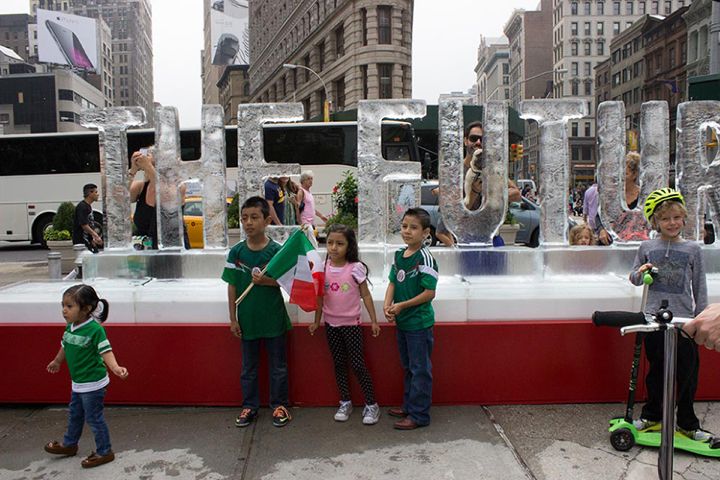
We knew it was coming—everyone knew it was coming—but we hadn’t been ready to admit that it was already here until Long Beach and the Florida Keys and various other barrier reefs along the coast were gone. Well, almost gone: They were gone at high tide but they miraculously reappeared twice a day. We watched this on TV.
We’d been through this before. With Katrina (almost). With Sandy. The difference this time was that we never got to the recovery portion of the news cycle. This time, like those, our lives weren’t affected—or I should say, our lives weren’t negatively affected. We lived up the hill, in the Heights, far away from the evacuation zones and the flooded houses, what we glibly called “the action.”
We could almost forget how, except for the jarring sense of unease that came over us when we thought about Cora’s second cousin and the timeshare in the Outer Banks she’d refused to abandon until its stilts had been swept up from under it and it had collapsed, the question we asked ourselves when we thought of her: when would we be affected? And would we be as bullheaded as she was about refusing to accept our new reality? Would we know enough to mourn and then adapt?
These were questions we could put off for now. That’s what we told ourselves. And in those early weeks, we almost convinced ourselves that a new and beautiful collective society might sweep in with all that water. No one was going to work—they couldn’t get there. The bridges were closed. The tunnels were flooded. We lived in one of those rifts that sometimes open up in history, the surreal goodwill that cracks over the city in the aftermath of crisis. Everyone, and their houseguests, refugees from Red Hook and the Battery, spent their days hanging out on the boulevards, in the park.
Cora and I kept bumping into people we’d made and broken so many dates with that we’d long ago given up on seeing them. Now, with nothing to do but wait for the new normal, we rekindled these friendships with drinks in the afternoon and dinners out at any of the numerous artisanal restaurants that were all still open at that time. We joked about what a boon this would be for the rooftop gardens and backyard chicken coops in Brooklyn, all that urban farmland that we rhetorically supported without ever having actually experienced. We speculated about how our real estate would appreciate now that our hood was the only one left standing. We worried about all the people who’d been displaced. We turned serious sometimes, when we ran out of jokes, and wondered how many of the dead still hadn’t been found and speculated about cholera and mass burial graves, because, really, what else were they going to do with all those people? We shook our heads in disgust, thinking about all ways the government had cynically allowed this to happen, encouraged it to happen, made money off of and picked up votes because of their willingness to allow it to happen. And we tried to assuage our guilt at having survived by reminding ourselves that we’d been on the side that tried to prevent it.
That was all before. We know better now, not that knowing better does us any good.
Watching the Future Melt Away
Ryan Schlief, International Accountability Project
It’s the opposite of watching paint dry.
Each shiny letter is slowing loosing its weight and form just sitting here. And I am just sitting here watching it slowly come apart.

Melting is faster and more unexpected than drying. I am waiting for the middle “T” in “FUTURE” to loose its balance and slide. The sculpture is not dripping water — small and steady streams are running down the corners of the table. The decay of the sculpture is inevitable.
I’ve watched ice melt before. Growing up in Minnesota, I saw icicles drip and the snowdrifts disappear into the ground each spring. I knew this would happen the same way year after year – so I gradually watched less intently.
But I’ve never tried to stop ice melting. Here, among the tall buildings, the tourists and spectators in New York City, I am not sure how we would even start. We could cover the ice with plastic to limit the erosion from wind and the occasional drops of rain today. A sign asking people not to touch the sculpture may help. As each letter falls, we could repair it somehow or maybe just add a new letter. The whole process feels very much out of my control.
But, this sculpture was made to melt. I don’t think we were meant to save the sculpture or repair it or cram it into a freezer at the bodega across the street until we came up with a better plan. The sculpture is already not what it was this morning — so what are we saving anyway?

Natural events are not happening the same way year after year. Out of habit and trust, maybe we were not watching as closely before, but we have seen and felt the changes. World leaders are meeting again this week and it is time to choose the people and environment first. They need to be bold and we need to be bolder.
As the sculpture continues to do what it is meant to do, it’s inevitable falling apart is in contrast with the massive coming together around me. Watching this grow thankfully is nothing like watching paint dry or ice melt. It gives me incredible hope.
Ryan Schlief is the Executive Director of the International Accountability Project – an international human rights organization that seeks to create new global policy and practice for development that respects people’s homes, environment and human rights. IAP is a supporting organization of the People’s Climate March.
The People’s Climate March on 21 September 2014 demands world leaders to end climate change. @melted_away presented a 3,000 pound ice sculpture in New York City and invited artists and activists to be writers in residence during the March.
That Ever Elusive Future
Chantal Bilodeau

I have read dozens of reports and articles about climate change, and heard at least as many scientists talk. I can confidently say that I understand the basic science and that I am aware of the potential consequences of our actions. Yet that understanding hits me most profoundly when I am confronted with a piece of art that helps me not just understand but feel the impact of climate change.
I have been watching The Future melt for over two hours now, and every time a piece breaks off, a little piece of my heart breaks off with it. I have grown attached to this melting block of ice and feel, on a very small scale, the sense of loss that perhaps we are not allowing ourselves to feel on a much bigger scale. I am reminded that the future is both beautiful and fragile and that at a moment’s notice, it may fall apart. And I can’t help but think about the Buddhist teaching that says that we only ever have the present moment. The future never arrives. It is always out there, slightly out of reach. But its quality is forever determined by what we make of each moment.
By the end of the day, The Future will be reduced to a puddle of melt water. But hundreds of people will have engaged with it: touched it, photographed it, talked about it, posted or tweeted about it. They may not remember or even know that we recently passed the 400 ppm threshold, or that the Arctic is warming faster than the rest of the world. But they’ll remember the poetry of a melting block of ice. Perhaps they’ll even be touched by it and shape their next present moment in a way that protects that ever elusive future.
Ha! said the 3AM Guy
John Weir
The 3 AM guy is planning my outfit for the giant melting ice sculpture at the Flatiron Bldg., where we’ll be anon. He’s going as a polar ice cap, of course. I want to go as him, which he’s not crazy about.
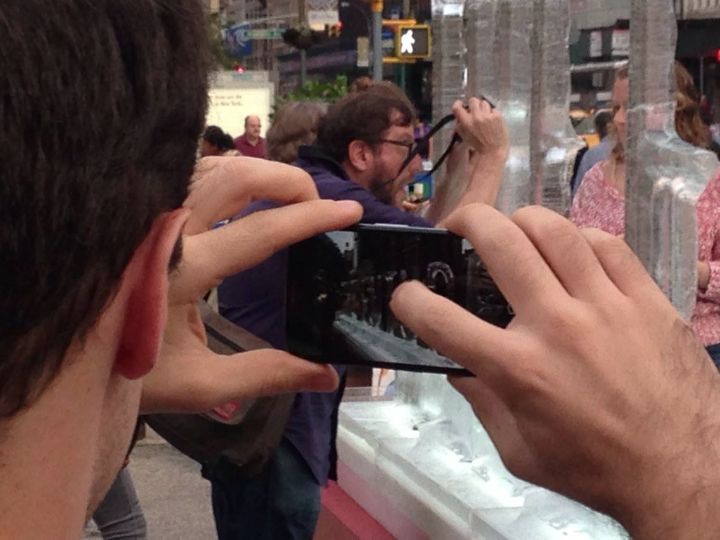
Me photographing people photographing melting ice, aka The Future.
The wifi is wonky at THE FUTURE, a big ice sculpture on 23rd Street across from the Flatiron bldg., NYC, so forgive me if I’ve posted this already, but: I’m at THE FUTURE, at the Flatiron building, watching ice melt. THE FUTURE is a big ice sculpture, and it’s been here since 9 AM, soaking up exhaust fumes from 5th Avenue and delighting European tourists streaming out of Madison Square Park. The sculpture was made by Nora Ligorano and Marshall Reese. I don’t know them. Neither does the 3 AM guy, who isn’t here yet. He decided he’s a polar ice cap, and he’s up north where ice caps live, waiting to melt. It won’t be long! He’ll wash up here in a minute, I think, clogged with whatever garbage he collects along the way.
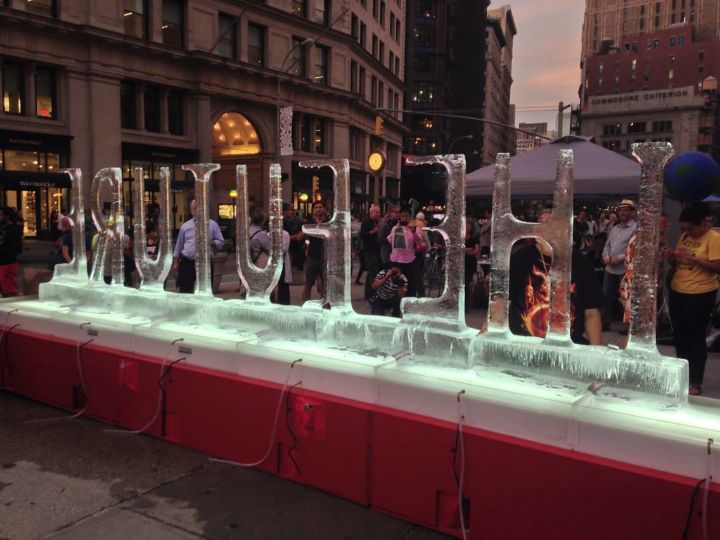
THE FUTURE is backwards, because I’m behind it, a moment before the T in THE collapsed.
The 3 AM guy just washed up on a tide of ice water from the increasingly-less-frigid north. He picked up a couple of stripped cars along the way and some of those 6-pack-beer-can-plastic-holding-things that choke swans, and he is clutching a Big Gulp (the 3 AM guy is nostalgic for Mayor Mike) that’s been empty for quite a while, and he is already engaged in an argument with a perfectly nice man in cargo pants and a pressed shirt who asked him in an “I’m-not-starting-a-fight-or-anything” tone if the 3 AM guy really knew what the hell he was talking about with this quote climate change unquote thing, and the 3 AM guy said, “Beats me. All I know is it isn’t as cold up north as I thought it would be, and then – whoosh! – I was floating in the Hudson with the other garbage, and I thanked Congress and the wealth of nations for the quick commute!”
—
Now THE FUTURE, which is missing THE’s T, is lit up from below as night falls in NYC, and the 3 AM guy doesn’t like that sentence, he says it’s faux poetic, so here: I’m in a metal chair on a concrete slab of traffic island that splits 5th Avenue from Broadway. The Flatiron Building’s not flat, it’s a triangle curved at the apex, the 3 apices, and the sky above it is della robbia blue, blue of the robe, with white clouds. Cirrus clouds? I wish I knew the names of clouds! “Cirrus” means “ringlet of hair.” The sky’s robe blue with curling locks of hair, and the traffic on 23rd Street is continuous and loud, and there’s a billboard for the iPhone 6 jutting at an angle down Broadway, and fairy lights are strung around the lemonade stand in Madison Square Park. People with cellphones are standing in front of the melting ice sculpture taking pictures of what they can’t see because they’re busy taking pictures of it. Later, they will turn up in your Facebook feed. The pictures, not the people. Though maybe also the people. The 3 AM guy loves climate change, he loves floods and famine and ruined tunnels for the R train, which I took here, because they just fixed the ruined-by-Hurricane-Sandy R train tunnel under the river from Brooklyn into Manhattan last week, and I like the R train! The 3 AM guy says, “Let it flood, you’ve got your mother’s car, what are you complaining? Pump exhaust and carbon monoxide fumes into the air while you cry about dry lakes in the Levant, hypocrite.”
—
I’ve got 30 minutes left to watch THE FUTURE melt and think deep thoughts – Ha!, says the 3 AM guy – and I’m thinking about the last full night I remember spending in Manhattanworld before I moved to the Republic of Brooklyn, BKNY, 18 months ago, after 33 years – lifetime of Christ! – living in one illegal sublet or another up and down Melville’s Island of the Manhattoes – I lived in two different apartments on West End Avenue, I lived on Avenue A with a boyfriend (as close as I’ll ever get to married), I lived in somebody’s mother’s temporarily empty apartment (she was in Florida) in a brutalist apartment complex under the Brooklyn Bridge, I lived on First Street in EVil for 13 years in an apartment that was painted bubble gum orange, I lived with 2-lawyer families in a building on Columbus Avenue, and the last place I lived in Manhattan was in BatShip, 47th Street & 10th Ave up the Street from the Battleship Intrepid, in a railroad flat between two gay bars, Hardware and BarTini, and that’s where I was when Hurricane Sandy happened, and Manhattan was blacked-out from the Battery to about 28th Street, for like a week.
—
Lower Manhattan was dark! I went out one night from 47th Street and walked downtown, through Hell’s Kitchen into Chelsea and the West V and then across town to the East V, at about 9 PM, and then all the way down to the Staten Island Ferry, and then I walked home, and the only light I saw was a pizza parlor on 24th Street whose industrious owners had hooked up their lights to a generator, and they were pumping a circle of light and a lot of pizza into the darkness, Edward Hopperishly. Some restaurants in the West V were open and lit by candlelight, and there were men in yellow safety vests standing around the R train entrance at Whitehall in Lowest Manhattan, pumping water out of the tunnel and barking at me to get away, so I got away.
—
On the way home, I stopped at the intersection of 7th Ave & Greenwich Ave & 11th Street, stood in the middle of the street, there were no cars, no lights, it was kind of thrilling, and the big wrecked remains of St. Vincent’s Hospital were gaping and mouthy and visible against the sky. It was the intersection where I met my first boyfriend, and where my best friend died, and though I’d lived in Manhattan for three decades, and my father worked for 45 years in the RCA Building – if I have a center it’s Rockefeller Center – : though I tell myself I’ve known Manhattan in pretty much all of its moods, since I was 3 months old, nonetheless, I had never stood in the middle of the empty street in the dark of night surrounded by unlit buildings in the silence of 11 PM, with my arms out, thinking of my friend who died in the hospital that was no longer there, and there was a mild breeze, and somewhere in the ghostly past poor Herman Melville, failed novelist, was trudging home from his dreadful job at the Customs House at the foot of Gansevoort Street – named for his father-in-law’s family! – and I thought, well, even Hermie must have had gas lights.
—
And I mean I was living a mile from the Twin Towers on 9/11 and walked down there in time for the second Tower to fall, and people were walking uptown towards and away from me in face masks and covered with white ash, and the East Village was patrolled by armored tanks for maybe a month afterwards, but even that was not as scary and weird as the whole thumb-stump of Lower Manhattan dark and underwater, and you make of disaster what you can! You go for a long walk and think about the dead, and stand in the middle of the street. But I wouldn’t want that opportunity again, which is why I’m posting this, and the 3 AM guy agrees.
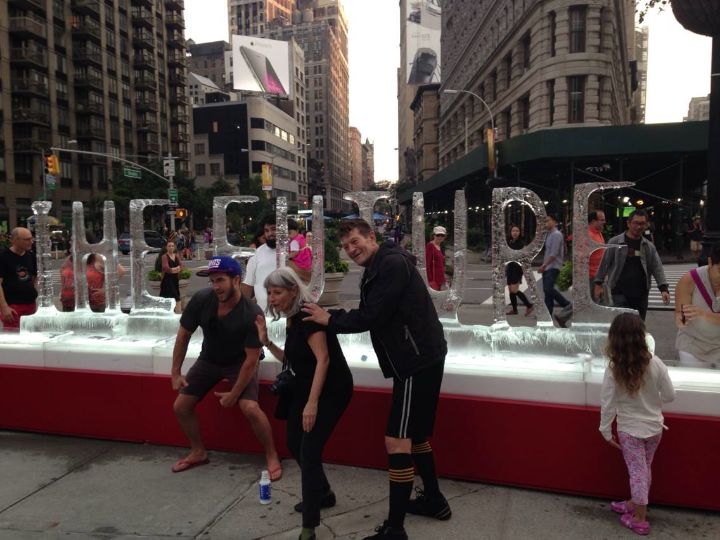
People gamboling before The Future as it dissolves.
T H E F U T U R E is melting
Mira Schor
I’m picking up from fellow writer in residence James Sherry at Ligorano Reese’s The Dawn of the Anthropocene public art work, in the shadow of the Flat Iron building. I’m looking out at the letters T H E F U T U R E carved out of ice melting. People are posing in front of the letters. It is hard to know how many are doing so because that is just what we do these days when something highly photogenic is made available to us.
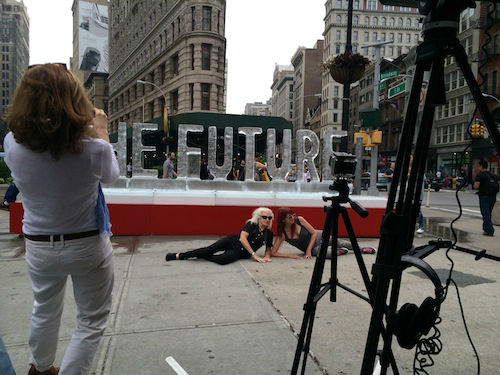
Today is a day of activism or of promoting consciousness of climate change and LigoranoReese’s image provides such an accessible metaphor. But in that transaction of posing and photographing, what gets communicated and what melts from political consciousness?
RISK
James Sherry
I am nearing the end of my 2-hour residency at the melted_away ice sculpture at the Flatiron building but I wanted to talk a bit about risk because there’s a lot of fear around change. Culture provides the will to change, but it also inhibits change by giving us models we are familiar with, that make us comfortable. So there is risk in change. The question is do we want to control that change and control the risk? Or do we want to let the change take place and avoid responsibility? So often we act and make things worse, so there’s a lot of reason to let change take place rather than act to make things worse.
Since, however, we are always acting, let us act on our own behalf and make those changes with risk in mind. Here at the Flatiron, Nora and Marshall are letting the words THE FUTURE melt_away. THE FUTURE will be gone by 11pm tonight. Expand that time frame and our inaction on climate change, allowing only the destructive elements of corporate development to act, and our civilization will melt_away. Can we think of an alternative action? The Anthropocene ice sculpture stands for THE human FUTURE. The planet will be fine without us. It’s time to come together to act. The Climate March raises awareness for decision makers that we are not silent; we are prepared to act; we expect them to act in accord with our interests, our long term interests.
Social Environment
James Sherry
At the beginning of the Humanist era, Geoffrey Chaucer wrote about a society where everyone was defined by their jobs: the knight, the squire, the priest, the housewife, the nun, and each had a separate story. In the environmental age people will start to identify themselves with how they view nature and all the stories have a common thread. Nature can be a cornucopia driven by our skills. Or we can passively receive its bounty, living from the fruits of other’s labor. We may think we cannot effect the world and hide away improving ourselves. All these different social beings contribute to arresting climate change, each in their own way. And we are not one thing as in humanism. Our view of nature changes as we do different things, washing dishes, skiing, working in the office…
Our common thread: humanity and nature as a single complex entity. As long as we continue to think of humanity as separate from nature, our solutions will be partial and their effects minimal. Social change drives climate change. We are both separate individual organisms and united by society and ecosystem. Michael Thompson is the inspiration for this thought.
Hot of the Presses
Just finished printing this beautiful 18 x 24 inch full-color offset broadside for the Dawn of the Anthropocene Future ice sculpture this Sunday, September 21.
We’re giving the poster away for free during the event from 10 AM to 10 PM.
As the Future disappears, we felt the need to leave behind and give a message to inspire others for continued commitment to solving the climate crisis.
We found a wonderful passage from Rachel Carson, author of the pioneering book Silent Spring which ignited environmentalism and a statement from Rebecca Solnit on the importance of amplifying individual actions into the power of many.